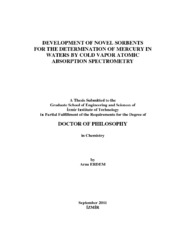Please use this identifier to cite or link to this item:
https://hdl.handle.net/11147/2887Full metadata record
| DC Field | Value | Language |
|---|---|---|
| dc.contributor.advisor | Eroğlu, Ahmet Emin | en |
| dc.contributor.author | Erdem, Arzu | - |
| dc.date.accessioned | 2014-07-22T13:48:33Z | - |
| dc.date.available | 2014-07-22T13:48:33Z | - |
| dc.date.issued | 2011 | en |
| dc.identifier.uri | http://hdl.handle.net/11147/2887 | - |
| dc.description | Thesis (Doctoral)--İzmir Institute of Technology, Chemistry, İzmir, 2011 | en |
| dc.description | Includes bibliographical references (leaves: 138-143) | en |
| dc.description | Text in English; Abstract: Turkish and English | en |
| dc.description | xx, 143 leaves | en |
| dc.description.abstract | Mercury is one of the most toxic heavy metal ions to all living organisms. A novel solid support with selective functional groups was developed for mercury sorption from waters prior to its determination by cold vapor atomic absorption spectrometry. The support was prepared by immobilization of several functional groups (amino, mercapto, etc.) on silica. Among the sorbents developed, 3-MPTMS-silica has been shown to be an efficient material for the sorption of mercury species due to its selectivity. Sorption experiments were performed to optimize the necessary parameters and conclusively, sorption pH of 7.0, reaction temperature of 25 oC, sorbent amount of 10.0 mg and shaking time of 30 min were applied throughout the study. Various mineral acids, organic acids, oxidizing agents and sulfur- or nitrogen-containing ligands were tried for the elution of mercury species and 2.0 M TGA was found to offer the maximum desorption. The validity of the method was checked via spike sorption experiments with four different types of water; namely, ultra pure, bottled drinking, tap and sea water. The method worked efficiently (>95%) for all types of water. Permeable reactive barriers, such as zero-valent iron and zero-valent copper were also applied for the removal of mercury species. Similar optimization parameters with 3-MPTMS-silica were also obtained for both sorbents. The method validation was also performed and although sea water is a heavy matrix, high uptake results were achieved for both sorbents. | en |
| dc.language.iso | en | en_US |
| dc.publisher | Izmir Institute of Technology | en_US |
| dc.rights | info:eu-repo/semantics/openAccess | en_US |
| dc.subject.lcsh | Mercury--Analysis | en |
| dc.subject.lcsh | Water--Analysis | en |
| dc.subject.lcsh | Atomic absorption spectroscopy | en |
| dc.subject.lcsh | Fluorescence spectroscopy | en |
| dc.subject.lcsh | Sorbents | en |
| dc.title | Development of novel sorbents for the determination of mercury in waters by cold vaporatomic absorption spectrometry | en_US |
| dc.type | Doctoral Thesis | en_US |
| dc.department | Thesis (Doctoral)--İzmir Institute of Technology, Chemistry | en_US |
| dc.relation.publicationcategory | Tez | en_US |
| item.languageiso639-1 | en | - |
| item.fulltext | With Fulltext | - |
| item.openairecristype | http://purl.org/coar/resource_type/c_18cf | - |
| item.openairetype | Doctoral Thesis | - |
| item.grantfulltext | open | - |
| item.cerifentitytype | Publications | - |
| Appears in Collections: | Phd Degree / Doktora | |
Files in This Item:
| File | Description | Size | Format | |
|---|---|---|---|---|
| 413590.pdf | DoctoralThesis | 6.92 MB | Adobe PDF |  View/Open |
CORE Recommender
Page view(s)
122
checked on Jul 22, 2024
Download(s)
28
checked on Jul 22, 2024
Google ScholarTM
Check
Items in GCRIS Repository are protected by copyright, with all rights reserved, unless otherwise indicated.